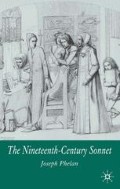Abstract
Part of the reason for the rather belated revival of the amatory sonnet sequence was unquestionably the dominance of the Miltonic-Wordsworthian sonnet, but there were aspects of the amatory tradition itself which rendered it problematic for nineteenth-century poets and critics.1 Its origins in the work of Petrarch and his numerous imitators gave it associations with insincerity and impropriety which proved difficult to eradicate, and the biographical emphasis in sonnet criticism which helped to mitigate the first offence only increased the seriousness of the second.2 Ever since the Abbé Jacques François de Sade revealed in the eighteenth century that Petrarch’s ‘Laura’ was not, as had often been supposed, a mere Platonic idealisation of beauty but a married woman, it became more difficult to see Petrarch’s love poetry as an arid intellectual game, but also more difficult to justify its existence on moral grounds.3 In his posthumously published introduction to The Book of the Sonnet, Leigh Hunt notes that numerous sonnet sequences from the earlier periods of the form’s existence ‘turn upon illegal attachments… [nobody] would dream, from [Petrarch’s] three hundred sonnets, that there was a gentleman of the name of De Sade, who had a right to ask him “what he meant”’.4 Byron’s observation in Don Juan is equally pointed:
-
There’s doubtless something in domestic doings,
-
Which forms, in fact, true love’s antithesis;
-
Romances paint at full length people’s wooings,
-
But only give a bust of marriages;
-
For no one cares for matrimonial cooings,
-
There’s nothing wrong in a connubial kiss:
-
Think you, if Laura had been Petrarch’s wife,
-
He would have written sonnets all his life? (III, 11. 57–64)
Access this chapter
Tax calculation will be finalised at checkout
Purchases are for personal use only
Preview
Unable to display preview. Download preview PDF.
Notes
See the discussion of the poem’s fluid and ambivalent relation to the available languages of sexual orientation in Alan Sinfield, Alfred Tennyson (Oxford: Blackwell, 1986), ch. 5; and below pp. 000–00 for the sonnet’s role as a vehicle for the coded articulation of homosexuality later in the century.
There is an analogy to be drawn here with Kingsley’s extraordinary (and even more disturbing) drawings of his future wife as a kind of sacrificial offering, stretched naked on the cross. Kingsley did not, of course, publish these drawings; some of them are reproduced in Susan Chitty, The Beast and the Monk: A Life of Charles Kingsley (London: Hodder and Stoughton, 1974). A comparison with Patmore is suggested by Gardner in ‘“Decoding” Rossetti’.
The structure of the poem is analysed in Robert D. Hume, ‘Inorganic Structure in The House of Life’, Papers on Language and Literature, 5 (3) (Summer 1969), 282–95;
Clyde de L. Ryals, ‘The Narrative Unity of “The House of Life”, Journal of English and Germanic Philology 69 (1970), 241–57.
A comparison first made by William E. Fredeman, ‘Rossetti’s “In Memoriam”: An Elegiac Reading of The House of Life, Bulletin of the John Rylands Library 47 (March 1965), 298–341. The poem’s relation to Rossetti’s own life, and in particular his relations with his wife Elizabeth Siddall and Jane Morris, wife of William Morris, has been the subject of a good deal of biographical speculation.
D.G. Rossetti, The Early Italian Poets (1861; rpt. London: Anvil Press, 1981), p. 123.
See Michele Martinez, ‘Christina Rossetti’s Petrarca’, Essays and Studies 2003 Victorian Women Poets, ed. Alison Chapman (Cambridge: D.S. Brewer, 2003), 99–121.
See for example Krista Lysack, ‘The Economics of Esctasy in Christina Rossetti’s Monna Innominata, VP 36 (4), 1998, which argues that the ‘silence’ of the final sonnet is actually a radical gesture which takes the poem ‘beyond conventional phallocentric speech’.
John Addington Symonds, Animi Figura (London: Smith, Elder and Co., 1882), pp. viii-ix.
Phyllis Grosskurth, John Addington Symonds: A Biography (London: Longman, 1964);
Phyllis Grosskurth ed., The Memoirs of John Addington Symonds (New York: Random, 1984).
The ‘Labouchere amendment’ to the Criminal Law Amendment Act of 1885 effectively outlawed homosexuality; see Elaine Showalter, Sexual Anarchy (London: Virago, 2001), p. 14.
Peter J. Holliday, ‘Symonds and the Model of Ancient Greece’ in John Pemble ed., John Addington Symonds: Culture and the Demon Desire (Houndmills, Basingstoke: Macmillan, 2000), p. 85. The idea that homosexuality was medicalised as a condition in the late nineteenth century derives from Michel Foucault’s History of Sexuality: ‘Homosexuality appeared as one of the forms of sexuality when it was transposed from the practice of sodomy onto a kind of interior androgyny, a hermaphroditism of the soul. The sodomite had been a temporary aberration; the homosexual was now a species’; (Harmondsworth, Middx.: Penguin, 1984), p. 43.
See for instance Richard Jenkyns, The Victorians and Ancient Greece (Oxford: Basil Blackwell, 1981), pp. 280–93;
Linda Dowling, Hellenism and Homosexuality in Victorian Oxford (Ithaca: Cornell University Press, 1994).
J.A. Symonds, The Sonnets of Michelangelo (1878; rpt. London: Vision Press, 1950), p. 11.
John Addington Symonds, In the Key of Blue and other Prose Essays (London: Elkin Mathews and John Lane, 1893), pp. 61; 66; 75.
John Addington Symonds, Vagabunduli Libellus (London: Kegan Paul, Trench, and Co., 1884), p. viii.
Symonds, Vagabunduli Libellus, pp. ix-xi. There are strong echoes here of Arthur Hugh Clough’s Dipsychus and The Spirit, another story of temptation to illicit love set in Venice. Symonds was extremely interested in Clough’s work, helping his widow to edit his poems for publication and write the ‘memoir’; see Howard J. Booth, ‘Male Sexuality, Religion and the Problem of Action: John Addington Symonds on Arthur Hugh Clough’, in Andrew Bradstock et al. eds, Masculinity and Spirituality in Victorian Culture (Houndmills, Basingstoke: Macmillan, 2000), pp. 116–33.
Copyright information
© 2005 Joseph Patrick Phelan
About this chapter
Cite this chapter
Phelan, J. (2005). ‘Illegal Attachments’: The Amatory Sonnet Sequence. In: The Nineteenth-Century Sonnet. Palgrave Macmillan, London. https://doi.org/10.1057/9780230512627_6
Download citation
DOI: https://doi.org/10.1057/9780230512627_6
Publisher Name: Palgrave Macmillan, London
Print ISBN: 978-1-349-51913-2
Online ISBN: 978-0-230-51262-7
eBook Packages: Palgrave Literature & Performing Arts CollectionLiterature, Cultural and Media Studies (R0)

